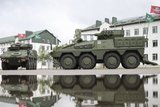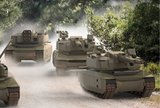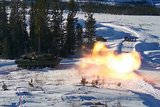BAE Systems elects to test HED system for GCV programme
The Hybrid Electric Drive (HED) system in development as part of BAE Systems’ Ground Combat Vehicle (GCV) proposal has completed 2,000 miles of testing on a fully integrated ‘Hotbuck’ mobility platform. The company reported that the testing, completed four months ahead of schedule, has been a success.
The Hotbuck is a stationary test stand that simulates real-life environments and terrain and puts actual miles on the HED system. The Hotbuck integrates HED components that will be used in BAE Systems’ GCV offering including the traction drive system, thermal systems, engines, generators, controllers and software.
Conducted at the BAE Systems Santa Clara, California, facility, the 2,000-mile advanced testing precisely replicated conditions at two well-known military test tracks. According to the company, the results of the tests further validated the performance, efficiency and maturity of the HED technology applied in BAE Systems’ GCV design, marking a significant milestone for its work on the Technology Development (TD) phase of the programme.
Mark Signorelli, vice president and general manager of Armored Combat Systems at BAE Systems, said: ‘This testing achievement is a significant advancement in the overall GCV programme. With actual hardware to show, this puts the BAE Systems team ahead of schedule both now and in the next phase of the programme, saving the customer development time and money.
‘Our primary objective was to test our hybrid electric technology over time against realistic environments, and the successful completion of the testing is a testament to the quality and maturity of the technology.’
Developing and testing actual hardware was not a programme requirement for the TD phase, but BAE Systems said it chose to take the initiative to demonstrate the fuel efficiency and performance of a hybrid system for the US Army’s next infantry fighting vehicle.
BAE Systems was awarded a contract for the TD phase of the GCV programme in August 2011. General Dynamics Land Systems was also awarded a contract under this phase of the programme. TD phase work is scheduled to be complete by June 2014.
More from Land Warfare
-
![Hungary set to begin using Hero 400 loitering munitions]()
Hungary set to begin using Hero 400 loitering munitions
Developed by Israel's Uvision and with systems being sold in the thousands to multiple European NATO countries and the US, the Hero family of loitering systems is also in production in the US and Italy, the latter through Rheinmetall.
-
![Croatia orders Leopards and CAESAR howitzers as Lithuania orders more CAESARs]()
Croatia orders Leopards and CAESAR howitzers as Lithuania orders more CAESARs
The Leopard is becoming the tank of choice in central and eastern Europe as Croatia joins Lithuania, the Czech Republic and Hungary in ordering the platform. Lithuania and Croatia have also signed for CAESAR howitzers.
-
![Light Reconnaissance Strike – enabling a vital mission set (Studio)]()
Light Reconnaissance Strike – enabling a vital mission set (Studio)
A new system-of-systems concept will unlock digital integration of sensors and weapons for Light Forces, allowing them to shape the battlefield environment on their own terms and upgrade legacy platforms.






















